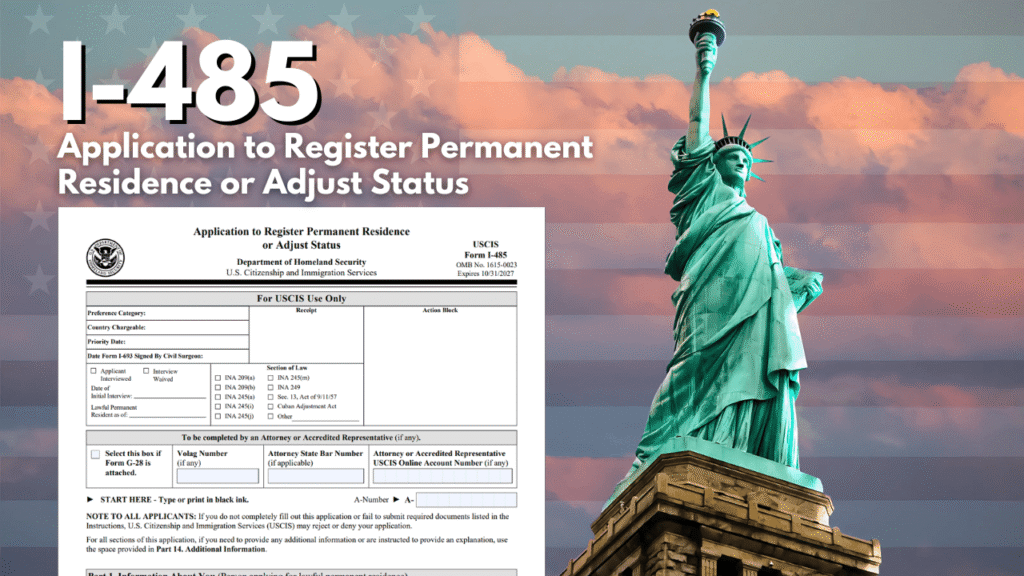A New Path to the United States,
I-485, Application to Register Permanent Residence or Adjust Status
Form I-485 – the official application to register permanent residence or adjust status. Whether you’re applying for your first 2-year green card or a 10-year permanent resident card, this guide is for you. Grab your form, and let’s walk through it—line by line.

Forms and Document Downloads
What is Form I-485?
Form I-485 is used to apply for lawful permanent resident status—aka a green card—while you’re physically present in the U.S. This form is used by millions of applicants every year under family-based, employment-based, asylum, and other humanitarian categories.
Where to File Form I-485
Your filing location depends on your eligibility category.
Visit the Direct Filing Addresses for Form I-485 page to find the correct address.
Note: If you file at a USCIS lockbox, your Form I-797 receipt notice may not include your A-Number right away. Don’t worry—USCIS will send it in a separate notice a few days later.
Form I-485 Filing Fee
Check the current fee using the USCIS Fee Schedule or try the Fee Calculator for help.
You can pay by:
✅ Money order
✅ Personal or cashier’s check (payable to U.S. Department of Homeland Security)
✅ Credit or debit card using Form G-1450
🚫 Fees are final and non-refundable, even if your application is denied or withdrawn.
💳 Credit/debit payments can’t be disputed later.
Submitting more than one form? Pay each fee separately—combined payments may cause your entire package to be rejected.
How to fill:
- You can complete it using Adobe PDF, but it must be printed and mailed.
- Black pen only for handwritten forms.
- Signatures must be original wet ink, or a photocopy of a signed page.
Part 1 – Personal Information
Let’s go page by page. Page 1 starts with a ‘For USCIS Use Only’ section – leave that blank. Same goes for the ‘Attorney or Representative’ section if you’re not working with one.”
- Current Legal Name: Use your official, legal name. If it’s changed, include documentation.
- Other Names Used: List nicknames, maiden names, or previous legal names.
- Date of Birth Format: MM/DD/YYYY
- Gender: Only male/female options are provided.
- Place of Birth vs. Nationality: Understand that birth country and nationality may differ.
- A-Number (if any): Found on EADs, NTAs, or previous USCIS documents.
- USCIS Account Number (if any): Optional, if you’ve created an online USCIS account.
Page 2 – Addresses and Arrival Info
Make sure your mailing address is secure and where you actually receive mail. You can list a safe mailing address if you’re applying under VAWA or similar cases.”
- Social Security Number: Only request a new card if you’ve never had one.
- Last Arrival Info:
- Passport or travel document used.
- City/state of last arrival.
- Date of arrival.
- Type of entry (airport, land border, etc.).
- If you entered unlawfully, describe the approximate location.
Page 3 – Immigration History
Now let’s get into the legal details of your last entry into the U.S.”
- Inspected and admitted or paroled? This determines your eligibility to adjust.
- Entered without inspection: Means you crossed without going through a port.
- Fake documents: These don’t count as “entry without inspection,” but as fraud.
- I-94 Record: Retrieve your electronic I-94 from the CBP website.
Section 2 – Adjustment Category
This is one of the most critical parts: What basis are you applying under?”
- Choose the correct category:
- Family-based (I-130)
- Employment-based (I-140)
- VAWA (I-360)
- Asylum, T/U Visa, Special Immigrant, etc.
- For derivatives, list the principal applicant’s name, receipt number, and priority date.
Part 3 – Personal History
Here you’ll enter your personal and address history from the past five years.”
- Address History: Every place you’ve lived in past 5 years.
- Employment History: Every job or period of unemployment for last 5 years.
- Parents’ Info: Full names, dates of birth, place of birth, current location.
- Marital History: Include total number of marriages, including annulments.
- Include both current and past spouses.
Part 6 – Children
You must list all children—biological, step, or adopted, regardless of their immigration plans.”
- Include their current status and whether they’re applying with you.
Part 7 – Biographic Info
Here’s where they ask for your race, ethnicity, eye color, height, and weight. Answer to the best of your ability. It’s used for biometric records.”
Part 8 – Inadmissibility Questions
This is the most sensitive section of Form I-485: 86 questions that determine whether you’re inadmissible for a green card.”
- Common flags:
- Working without authorization
- Criminal convictions
- Immigration fraud or misrepresentation
- Prior removal orders
- Arrest History: Even if it didn’t lead to conviction, disclose it.
- “Have you ever been cited, charged, or detained?” – applies your whole life.
If you answer ‘Yes’ to any inadmissibility question, seek legal help immediately. You may need to file a waiver.”
Public Charge Rule
Next, the public charge question: Are you subject to it? If you’re applying under VAWA, asylum, or T/U visas—you are exempt.”
- For others, you must show financial support and not rely heavily on certain public benefits.
That wraps up our walkthrough of the updated I-485 application. If you found this helpful, be sure to like, subscribe, and turn on the notification bell so you don’t miss our next immigration guide. If you have any questions, drop them in the comments section!
2 thoughts on “I-485, Application to Register Permanent Residence or Adjust Status”
Your articles are extremely helpful to me. May I ask for more information about form i485
your article is good every thing is understandable and readable